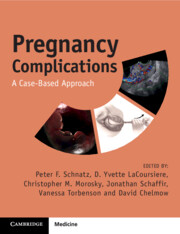Book contents
- Pregnancy Complications
- Pregnancy Complications
- Copyright page
- Contents
- Contributors
- Preface
- Note from the Editor-in-Chief
- Normal Laboratory Values (Conventional Units) []
- Section 1 Antepartum (Early Pregnancy)
- Case 1 A Patient of Ashkenazi Jewish Ancestry Presents for Preconception Counseling
- Case 2 A Patient with a Subchorionic Hematoma Presents with Early Vaginal Bleeding
- Case 3 A 25-Year-Old with a Twin Gestation at 9 Weeks
- Case 4 A 35-Year-Old with HSIL Cervical Cytology at 10 Weeks
- Case 5 A 20-Year-Old with a Molar Pregnancy at 8 Weeks
- Case 6 A 20-Year-Old with Anxiety and Depression at 7 Weeks
- Case 7 A 40-Year-Old with Nausea, Vomiting, and Weight Loss at 7 Weeks
- Case 8 A 30-Year-Old with Worsening Migraine Headaches at 14 Weeks
- Case 9 A 30-Year-Old with Isoimmunization at 9 Weeks
- Case 10 A 25-Year-Old with an Early Pregnancy and Bicornuate Uterus
- Case 11 Recommended Vaccinations at an 8-Week Prenatal Intake
- Section 2 Antepartum (Mid-trimester)
- Section 3 Antepartum (Late Pregnancy)
- Section 4 Antepartum (Medical Complications)
- Section 5 Antepartum (Infectious Complications)
- Section 6 Intrapartum/Delivery
- Section 7 Postpartum
- Section 8 Fetal Complications
- Section 9 Placental Complications
- Section 10 Complications of the Cord, Amnion, and Gravid Uterus
- Section 11 Psychosocial Considerations
- Index
- References
Case 3 - A 25-Year-Old with a Twin Gestation at 9 Weeks
from Section 1 - Antepartum (Early Pregnancy)
Published online by Cambridge University Press: 08 April 2025
- Pregnancy Complications
- Pregnancy Complications
- Copyright page
- Contents
- Contributors
- Preface
- Note from the Editor-in-Chief
- Normal Laboratory Values (Conventional Units) []
- Section 1 Antepartum (Early Pregnancy)
- Case 1 A Patient of Ashkenazi Jewish Ancestry Presents for Preconception Counseling
- Case 2 A Patient with a Subchorionic Hematoma Presents with Early Vaginal Bleeding
- Case 3 A 25-Year-Old with a Twin Gestation at 9 Weeks
- Case 4 A 35-Year-Old with HSIL Cervical Cytology at 10 Weeks
- Case 5 A 20-Year-Old with a Molar Pregnancy at 8 Weeks
- Case 6 A 20-Year-Old with Anxiety and Depression at 7 Weeks
- Case 7 A 40-Year-Old with Nausea, Vomiting, and Weight Loss at 7 Weeks
- Case 8 A 30-Year-Old with Worsening Migraine Headaches at 14 Weeks
- Case 9 A 30-Year-Old with Isoimmunization at 9 Weeks
- Case 10 A 25-Year-Old with an Early Pregnancy and Bicornuate Uterus
- Case 11 Recommended Vaccinations at an 8-Week Prenatal Intake
- Section 2 Antepartum (Mid-trimester)
- Section 3 Antepartum (Late Pregnancy)
- Section 4 Antepartum (Medical Complications)
- Section 5 Antepartum (Infectious Complications)
- Section 6 Intrapartum/Delivery
- Section 7 Postpartum
- Section 8 Fetal Complications
- Section 9 Placental Complications
- Section 10 Complications of the Cord, Amnion, and Gravid Uterus
- Section 11 Psychosocial Considerations
- Index
- References
Summary
Zygosity determines the genetic composition of a twin pregnancy and is best determined by a first-trimester or early second-trimester ultrasound. All twin pregnancies should be offered genetic testing and be counseled on weight gain recommendations and specific micronutrient needs. Monozygotic, specifically monochorionic gestations, are at the highest risk of complications leading to additional interventions and antenatal testing. Due to an increased risk of stillbirth, twin gestations are delivered earlier than singleton gestations. The route of delivery is dependent on the presenting twin and experience of the delivering clinician. All monochorionic-monoamniotic gestations are delivered by cesarean section.
Keywords
- Type
- Chapter
- Information
- Pregnancy ComplicationsA Case-Based Approach, pp. 7 - 9Publisher: Cambridge University PressPrint publication year: 2025

